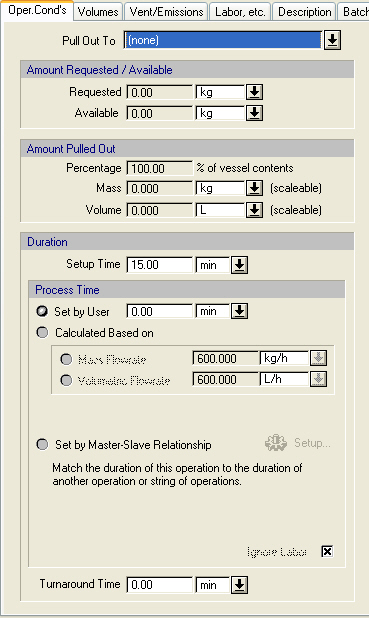

The following table shows a brief description of the variables appearing in this tab. The table also displays their default values and their generally acceptable range:
|
Variable |
Default Value |
Range |
|
|
||
|
○ Pull Out To Port / Stream |
<None> |
Any Output Port |
|
● Requested Amount (kg) |
0.0 |
Positive |
|
● Available Amount (kg) |
0.0 |
Positive |
|
● Percentage Pulled Out (% of vessel contents) |
100.0 |
0-100 |
|
● Mass Pulled Out (kg) |
0.0 |
Positive |
|
● Volume Pulled Out (L) |
0.0 |
Positive |
|
○ Setup Time (min) |
15.0 |
Positive |
|
◙ Process Time (min) |
0.0 |
Positive |
|
◙ Mass Flowrate (kg/h) |
600.0 |
Positive |
|
◙ Volumetric Flowrate (L/h) |
0.0 |
Positive |
|
○ Ignore Labor? |
Yes |
Yes/No |
Symbol Key: ○ User-specified value (always input); ● Calculated value (always output); ◙ Sometimes input, sometimes output
The following list describes the available specification choices in this tab; for more details on how these are implemented, see Pull Out: Modeling Calculations.
The Pull-Out Oper.Cond’s interface is, in many ways, similar to the Transfer Out interface, see Transfer Out: Oper. Conds Tab. You can think of a Pull-Out operation as a Transfer Out Operation, with one very important difference: While for a transfer out operation, you specify the amount being transferred as part of the operation’s setup, in a pull-out operation that amount is already specified by some downstream operation (e.g. a wash). Notice that the boxes showing the amount-related data (percentage, mass, volume) are always greyed out – i.e. they cannot be edited by the user.
•Duration options...
The duration of the operation can be calculated by the following ways:
a) Set directly the user
b) Calculated based on a user-specified mass or volume flow rate, or
c) Tied up to another operation or operation sequence by exploiting the Master-Slave relationship. If you introduce a master-slave relationship, the program will match the setup time, the process time and the turnaround time of this operation (the ‘slave’) with the corresponding times of the reference operation (the ‘master’ operation). For more details on how to setup a master-slave relationship, see The Scheduling Tab.